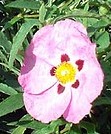 Rock rose is an evergreen shrub from the Mediterranean region from Portugal to Italy that boasts large beautiful flowers in spring and outstanding drought tolerance once established. Even if the foliage wilts during times of high temperatures the plant will rebound as soon as rain returns. Rock rose does well in seaside areas where it is able to withstand wind as well as salt spray. In spite of its Mediterranean origin, however, it can even be grown in areas with wet humid summers if excellent drainage is provided. The toughness of rock rose to adverse conditions may be related to its ability to produce mycorrhiza, a symbiotic relationship with a fungus. The fungus absorbs water and minerals from the soil and makes it available to the rock rose so that the latter can survive in infertile and droughty soil. While this relationship is very beneficial to the rock rose, it makes transplanting it more difficult as the plant needs time to establish new mycorrhiza after being moved. As a result, avoid buying pot bound plants and plan to water regularly for about two years after transplanting.
Rock rose is an evergreen shrub from the Mediterranean region from Portugal to Italy that boasts large beautiful flowers in spring and outstanding drought tolerance once established. Even if the foliage wilts during times of high temperatures the plant will rebound as soon as rain returns. Rock rose does well in seaside areas where it is able to withstand wind as well as salt spray. In spite of its Mediterranean origin, however, it can even be grown in areas with wet humid summers if excellent drainage is provided. The toughness of rock rose to adverse conditions may be related to its ability to produce mycorrhiza, a symbiotic relationship with a fungus. The fungus absorbs water and minerals from the soil and makes it available to the rock rose so that the latter can survive in infertile and droughty soil. While this relationship is very beneficial to the rock rose, it makes transplanting it more difficult as the plant needs time to establish new mycorrhiza after being moved. As a result, avoid buying pot bound plants and plan to water regularly for about two years after transplanting.
 Type: Evergreen shrub
Type: Evergreen shrub
Outstanding Features: Showy flowers, drought tolerance
Form: Compact mound
Growth Rate: Moderate
Bloom: Papery, three inch wide pink flowers with yellow stamens and dark blotches at the base of each petal; late spring to summer
Size: 4’ H x 6’ W
Light: Full sun
Soil: Dry, well drained; tolerate infertile soil
Fertilizer: Apply complete fertilizer such as 6-10-4 in late winter or early spring
Hardiness: USDA Zones 8-11; Sunset Zones: 6-9, 14-24
Care: Prune to maintain shape in late winter
Pests and Diseases: None of significance
Propagation: Layering; cuttings
Outstanding Selections:
 ‘Brilliancy’ (clear pink flowers)
‘Brilliancy’ (clear pink flowers)
 ‘Betty Taudevin’ (deep reddish-pink flowers)
‘Betty Taudevin’ (deep reddish-pink flowers)
Comments: Attracts butterflies, bees, and hummingbirds.
